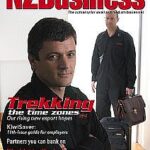Checking In
Kevin Kevany looks at trends in international business travel; some of the innovative services and facilities for business travellers; and shares some top tips from frequent flyers.
As with so many aspects of life today, what was “hot” last year is now taken for granted and operators in the business travel sector need to understand that they cannot stand still for a moment if they are going to maintain customer loyalty. Business travellers inevitably are under time and other pressures and expect their needs to be paramount with service providers up and down the chain – at all times. Failure to do so means they take their business elsewhere next time.
Airlines and hotel chains that kid themselves that national loyalty and habit will bring their annoyed customers back are simply out of luck.
“I regard it as a bonus if the national carrier has what I need at the right price and time, and then prove that they can deliver on my needs better than anyone else. That was the case until a few years back, but they’ve ‘lost’ it in recent times, seemingly as the bosses have both eyes firmly fixed on the stock exchange price, rather than giving it an occasional glance,” says Terry Malcomess, an agricultural consultant who flies a great deal locally, as well as to the Middle and Far East.
That was a recurring theme amongst our frequent flyer panel – a surging dissatisfaction with Air New Zealand and Qantas – opting to give their business to the Emirates, Singapore, Malaysia, Korean, Cathay Pacific and Thai airlines (as highlighted by a recent ACNielsen survey), which they feel provide value for money, uncomplicate their booking and check-in arrangements, and then provide good food, clean cabins and the best range of in-flight entertainment.
“And that doesn’t include the personal attention you are fussed with by really attentive (and good-looking) cabin staff,” says one of our panel, who wished to remain anonymous.
But there was a cautionary note for Emirates, sitting on top of the poll, from another panel member: “Don’t focus on adding new destinations at a cost to customer service.”
Another frequent flyer says she flew any airline linked to Star Alliance, flying twin-aisled aircraft without an A in the model type. And not surprisingly, seat comfort and leg-room is the greatest bugbear for many travelling in the “back of the plane”. Here too the big international carriers are apparently going all out to provide better spacing, depending on how broad or long-in-the-leg you are.
With regard to domestic flights, Air New Zealand especially, and Qantas with some grumbles, were pilloried for comfort and leg-room and the lack of food and beverage.
“It’s reaching the point where I’m considering catching the train down to Wellington, or even driving. It’s all very well to say that it’s only a 45-minute flight, but all of us have had occasions where we have been delayed, diverted and generally stuffed around, while knowing you could have got to Sydney sooner. Let’s not mention going to Dunedin via Christchurch either,” says one of our panel, who says she now prefers to fly internationally rather than locally, even though it takes her away from her family. “I come back in a better mood.”
New class of travel
Tracey Palmer, Air New Zealand’s corporate communications manager, points out that the airline’s new Pacific Premium Economy offers international travellers the chance to travel in a class that nestles between Business Premier and Pacific Economy.
“The service includes extra leg-room, better seat recline and a host of other enhancements, including pre take-off drinks, printed menus, meals designed by consultant chefs, snacks, hot towels, amenity kits, slippers (on selected flights) and noise-cancelling headsets. (One of our panel described it as: “The old business class, without the flat beds.”)
There has been some concession to changing passenger needs too – more flexibility on bookings.
“Meeting times can change at the last minute and to compensate for this Air New Zealand has offered even more flexibility to change flight times and destinations with its ‘flexisave’ airfares. Travellers on flexisave fares can change flight times right up until the day of departure where seats are available,” Palmer adds.
Ironically, while any discussion on business travel inevitably focuses on the relative strengths and weaknesses of airlines, according to the latest research from Wotif.com, it’s a comfortable bed that is top of the list of essential requirements.
“Overwhelmingly, 82 percent of respondents listed a comfortable bed as the most important aspect of their business trip; with location, modern décor, the inclusion of breakfast, free parking and Internet access in rooms, the next most important factors,” notes Tania Witheford, the New Zealand manager of the rapidly-expanding Australian-based and ASX-listed travel booking company.
“At the other end of the scale, well-equipped business centres, proximity to the airport and public transport and complimentary gifts on arrival (for example, wine or massages) were of little interest to business travellers.”
Business travel has moved even more rapidly online since the last survey – another fact confirmed by the Wotif.com site, which attracts almost 2.5 million user sessions a month, with customers making over 160,000 bookings through their 28-day booking window.
“Increasingly, business travellers are arranging their trips online with respondents signalling that price, simple navigation and the ability to make secure online payments are the driving factors for this continuing trend,” says Witheford. “Respondents to our survey said convenience, the ability to compare rates at a glance and instant confirmation capabilities were important features of a good on-line accommodation site.
“A large proportion of business travel is organised at the eleventh-hour, making online accommodation bookings the easiest and cheapest option for business travellers. Increasingly, too, we’re finding that companies encourage their employees to check for the best available deals online, prior to booking accommodation via their traditional methods.”
Other business traveller trends include:
• The move to more frequent, but shorter, trips – with the average business person travelling five to six times each year.
• Serviced apartments are becoming increasingly popular against the traditional four and four-and-a-half star hotels.
• Only one in five bookings are made more than a month ahead; with more than half less than two weeks before travel – reinforcing fewer regular “round the bases” trips and more spontaneous excursions.
• Business travellers like their accommodation fully prepaid.
Connectivity comparisons
The other major issue for our “runway warriors” is connectivity back to base and home. Business broker Henri Michaelis has this aspect of travelling “waxed”.
“Don’t bother with Telstra Wi-Fi at Sydney’s Kingsford Smith airport, the connection always drops and ‘restore’ means a full re-bill. Changi airport’s Wi-Fi is okay, but forget about getting a decent VPN connection, even in the SQ (Singapore Airlines) lounge.
“Suvarnabhumi, the new airport for Bangkok, where the Wi-Fi is tops, and free, hopefully will send a message to others to follow,” says Michaelis.
“Lufthansa lounges all have good solid Wi-Fi connections – but Vodafone New Zealand is way behind other Vodafone country franchises when it comes to roaming agreements with GPRS for Blackberry addicts, especially in the Middle East.”
Vodafone never got back to us, but Telecom jumped into the fray.
“We are launching a new global roaming service in late June that will enable Telecom customers to roam on ‘worldmode’ capable handsets in 180 countries around the world with all the same voice and SMS functionality they have in New Zealand,” says Telecom’s communications adviser (business) Katherine Murphy.
“This means one number and one mailbox – at a basic level it will be the same experience as Vodafone customers have currently, but with added benefits such as a 24/7 help desk, much greater coverage and ease of use.
“Telecom customers will also have a much fairer pricing structure, with fixed prices to each country that will ensure consistency and clarity – and mean the end to the bill-shock many business travellers experienced in the past.”
Watching the purse-strings
SME (small and medium enterprise) business travellers do not have the plush corporate funds to dip into, so how does our panel keep the purse-strings tight on trips?
“Plan well in advance and hound airlines to open flights for bookings. You won’t necessarily succeed, but you will find out when the flight you want will become available to book via the Internet,” says Michaelis.
“Also use public transport whenever it’s directly available from airport to downtown. It might take a little longer, but then there’s always an extra dollar or two in your pocket for coffee or a beer, if that’s more ‘culturally appropriate’,” he adds.
What about mixing pleasure with business? According to the Wotif.com survey, while three-quarters of respondents travelled either alone or with a business partner on trips, almost half admitted they try to incorporate a leisure component into each business trip, with many preferring to schedule meetings near the weekend. Nearly a third said they travelled with their partner or family on all business trips.
And what did our panel think of that?
“Read the IRD rules carefully and make sure you use the weekends carefully. Also be very clear as to what is covered by your travel insurance (which you must always have) when you mix pleasure and business,” says frequent flyer Terry Malcomess. “Read the fine print twice.”
Ron New, relationship manager for Mike Henry Travel Insurance, says they do cover all benefits and situations that a Leisure Policy provides, with additional benefits more specific to the business traveller. Some examples of this include cover for an alternative staff member to replace you if you cannot travel; cover for business items/equipment; and even cover for kidnap and ransom.
Many companies, including SMEs, are now requesting highly detailed levels of reporting after business trips, and according to Flight Centre Travel Solutions GM, Brendan Drury, employees are required to strictly adhere to travel policies and account for every cent of their corporate travel spend.
“It’s important to get their systems right or risk inappropriate or mismanaged expenditure as the company grows. Consequently, there is increasing pressure on travel management consultants to find ways to eliminate excess travel spend and negotiate the best deals in both accommodation and airline costs, all within corporate guidelines,” he says.
Drury claims it is not uncommon to achieve 30 percent cost savings on clients’ total travel spend within the first year – as well as providing the convenience of a one-stop-shop.
“The rise of the Internet has seen some businesses start trawling the web for domestic and trans-Tasman fares, at the risk of ‘DIY disasters’ – such as missing hidden costs, forgetting vital add-ons or miscalculating transfer times,” he warns.
And are there any final tips from our well-travelled executives?
“The piped music at Auckland International puts the immigration officers to sleep, so it’s quicker to go to the foreigners’ queue and take the rap for getting into the wrong one,” suggests one seasoned traveller. “Australia dishes out ‘credit cards’ to frequent business flyers and sets up a special line for them to flash their card.”
They are a picky bunch too.
“Only fly Qantas if you can go first-class – which is on par with other business class providers. Check that you have a flat bed and not one that is ‘shot’ already, otherwise you spend the night sliding off.”
“Cracks and chips are already appearing in Air New Zealand’s new business class seat frames where the plastic or fibreglass exterior is just not hard-wearing enough.”
And a final thought comes from Telecom’s Murphy: “Always consider our audio and web conferencing.” NZB
Kevin Kevany is an Auckland-based freeland writer.
Email [email protected]



